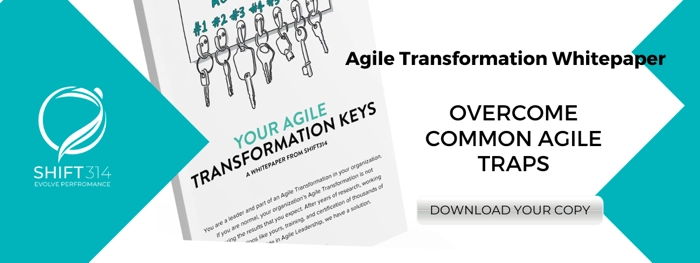Have you experienced this common trap? It’s an unintentional happening, often very subtle. Scrum masters and Product Owners that begin to act like traditional managers. They may not have the same sort of traditional ways of interacting, yet they have the same behaviors: pushing for results, thinking they’re right, thinking they’re smarter, and thinking that they’re in charge of what happens. Ignoring this tendency can lead to disaster. Embracing this tendency can actually unlock high performance.
Performance Depends on the Scrum Master and Product Owner
The performance of your team entirely depends on your Scrum Master and Product Owner. If you have a great Product Owner and great Scrum Master, your team is on its way to the extraordinary. If either one of those roles is challenged in any way, the team performance will be challenged. These are two critical roles on any Scrum or Agile team. Here are some essential qualities of highly effective and amazing Scrum Masters and Product Owners.
People Default to Hierarchical Roles
Scrum Masters and Product Owners are the new managers.
This is a controversial statement. “But isn’t the whole point of Agile to get rid of the managers?” Sure, in theory this works, but here’s the deal: as long as there are human beings, we’re going to have different levels of capability, different roles, and different levels of authority.
What happens if you get rid of all roles and distinctions of authority is it’s really confusing for people to organize themselves. People have a very natural desire to have some sort of sense of order. Putting people on teams and letting them know who’s going to guide the evolution of the product gives people a sense of order. Knowing there’s someone there to act as a coach, to facilitate, to help them learn and grow and evolve as a team and as individuals, gives people a sense of safety and security. Having roles and responsibilities is actually a very natural thing.
When people have evolved to the point where their inner sense of psychological safety is high enough, they don’t need these structures to function. That’s what we see on very advanced design teams and in improv where people just flow with whatever’s happening. Yet most of us are not psychologically prepared for that, we require a certain sense of order, a certain sense of structure for us to feel psychologically safe.
When people at their current level of consciousness take Scrum and apply it out of the box, people have an expectation that someone’s going to be in charge and tell them what to do.
When we introduce Scrum or Agile organizations, people are naturally going to project their current mindset and understanding of how things function onto Scrum. And people who are taking on the role of Product Owner and Scrum Master are going to project their own understandings of how people function together in hierarchy onto their role. In short, they become managers without the title.

Example: Low-Consciousness and High-Consciousness
Scrum masters and Product Owners become defecto managers – this is a fact for most organizations. But instead of ignoring that fact, embracing it allows leaders to facilitate the creation of a truly Agile environment, instead of one in name only. It all comes down to the level of consciousness at which the Scrum Master and Product Owner are operating. Let’s take an example.

A Low-Consciousness Product Owner
A low-consciousness Product Owner acts more like a traditional manager. They think it’s their job to tell people what to work on. But that’s not what the Product Owner role was intended to be.
Unfortunately, a Product Owner can act more like a command and control manager. They can be the new manager and push for results or their agenda, tell the team what to do and what to work on, not listen to other people, kill the performance of the organization, and create terrible products. Or they may create products that are not sustainable because they haven’t listened to the team or built-in long-term sustainability practices, such as test-driven development or continuous integration.
An Evolved Product Owner
A more evolved Product Owner understands that their role is to facilitate a conversation. Although a Product Owner makes the final decision because they have ownership and accountability for it, they understand the best decisions will come from the wisdom of crowds. They listen to all the people involved, the customers, the stakeholders, the team, other groups, to understand how this product interrelates with the other products.
When you have a Product Owner that has that more evolved mindset, then they can play the role of a Product Owner in a more evolved way without being an oppressive manager. They don’t go to that command and control type behavior that we all know so well. They lead through facilitation and influence.
However, most people need to go on an evolutionary journey to evolve themselves to the point where they can move from more of a directive role (command and control) to more of a facilitative role (evolutionary leadership), where they’re fully able to listen to people and involve them.
The Scrum Master
Everything you’ve just read applies fully to the Scrum Master. You can have a command and control Scrum Master who thinks they’re the owner of the process, that it’s their job to make sure the process is working well, they’re there to guide the team to be better.
The evolved Scrum Master is a very different kind of person. They understand that they’re there to serve the team. They’re there to help the team be as successful as they can be. And if the team doesn’t want to be successful, it’s not their job to make them. They’re not there to enforce the Scrum rules. They’re there to act as a mirror, to invite the team to be their best selves.
Modeling the Evolutionary Journey
The Scrum Master can only invite the team members to learn and evolve and grow when they themselves are modeling that growth. Thus, the Scrum Master is a very important leadership role. When the Scrum Master that learns to act as a leader, to inspire, to hold space, and invite change, they act as a powerful catalyst for helping that team become extraordinary.
Recognizing it’s a Temporary Role
An evolved Scrum Master understands they’re more like a coach that’s there on a short-term basis. They don’t want to build a long-term dependency. They just want to help the team become awesome and develop the capabilities they need to be extraordinary on their own. That’s what great managers do.
Guiding but not Controlling
Command and control Scrum Masters will use their knowledge and expertise in a way that will suppress the team and set their status higher. An evolved Scrum Master’s goal is to elevate the status of all the people. As an evolved Scrum Master, you can to grow, develop, and liberate the people that you’re guiding.
Quick Tips for Scrum Masters and Product Owners
The first step is to recognize that as a Scrum leader or Product Owner, how you show up impacts team performance. If you want to inspire connection and fuel the motivation for growth, it’s vital to focus on your own personal journey of evolution. It’s not just about learning new skills, it is about evolving yourself to really become what we call an Evolutionary Leader.
The foundation of evolutionary growth is awareness. Here are three things to become aware of:
Where is there turbulence in meetings?
Notice the places where there’s turbulence in relationships or turbulence in meetings. Also notice how much attachment to your ideas you have in any particular situation. Becoming conscious of your leadership habits and behaviors is a necessary first step to becoming a more evolved Scrum Master or Product Owner.
Where are you using authority?
You can also notice where you are using authority as a Product Owner or a Scrum Master. Where do you feel like you get to decide, that what should happen is your decision? These are places where you’re acting in a command and control framework. Seeing these places gives you an opportunity to look at your leadership edges and grow into a more evolved leader.
Where are you listening to others?
Where are you listening to others about what should happen? As a Product Owner or Scrum Master, are you listening to what should happen with the teams? Not listening is a sure sign you’re operating in a command and control framework.
Advice for Executives and Senior Managers
The first thing to ask is, how capable and competent are your Product Owners and Scrum Masters? Do the people who are in those roles know what they’re doing? Are they showing up in a way that leads and invites people to an evolved mindset – to the Agile Mindset or Evolutionary Mindset?
Many managers want a checklist or rubric. Our definition of Evolutionary Leadership provides clear guidance for what signs to look for in more evolved leaders. The challenge is we can only assess people from our own, perhaps limited, perspective. The work-around is to look at the performance levels of your teams.
You probably have a good idea of which teams are performing better. More than likely, those teams probably have better Scrum Masters and Product Owners.
As the managers of the system, it’s our responsibility to understand how well people are functioning. When we work with organizational systems, one of the first things we do is evaluate the Scrum Masters and Product Owners. Do they know practically what they need to do? And, how are they showing up? Do they have the right consciousness? Do they have the right mindset?
If you don’t have the capability or the expertise needed to evaluate that, that’s a great place to start asking for help and developing organizational capability.
Final Thoughts
We all have a desire to create better workplaces, better teams, better organizational systems, where people can show up at their best. This hope that changing our structures, moving to Agile, moving to Scrum, putting people on teams and having these new rules will somehow solve all the challenges of the past is inaccurate and misleading. The truth is that transformation and organizational change is a complex journey. It requires an evolution in how people are showing up to work within the system. And this often requires an evolution in one’s ability to lead change through extraordinary leadership. Evolutionary Leadership is a commitment to a journey of awareness, impact and the ability to lead through influence, showing up as a powerful and effective leader .

Agile is insufficient to fully resolve this challenge, because it’s just a partial specification of a culture system. It requires a much more integrated and sophisticated journey than Agile can afford. It becomes apparent that organizations that are fully in line with Agile are asking for the incredible results from Agile, yet not fully understanding that the shift of process and structures are dependent on a shift in the culture of an organization. And this goes beyond what Agile alone can achieve.
The SHIFT314 Evolutionary Leadership Framework™ (SELF) is a coherent structure for organizational transformation. The SELF™ system creates the future of work that we hope for and accesses the promise that Agile provides, sustainable success that has the ability to deliver extraordinary results in the complex world of business.


